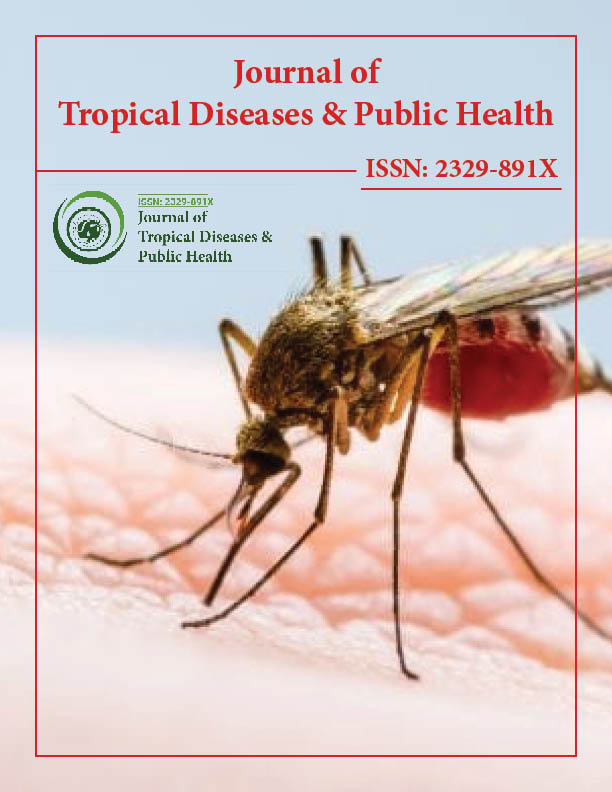Indexed In
- Open J Gate
- Academic Keys
- ResearchBible
- China National Knowledge Infrastructure (CNKI)
- Centre for Agriculture and Biosciences International (CABI)
- RefSeek
- Hamdard University
- EBSCO A-Z
- OCLC- WorldCat
- CABI full text
- Publons
- Geneva Foundation for Medical Education and Research
- Google Scholar
Useful Links
Share This Page
Journal Flyer

Open Access Journals
- Agri and Aquaculture
- Biochemistry
- Bioinformatics & Systems Biology
- Business & Management
- Chemistry
- Clinical Sciences
- Engineering
- Food & Nutrition
- General Science
- Genetics & Molecular Biology
- Immunology & Microbiology
- Medical Sciences
- Neuroscience & Psychology
- Nursing & Health Care
- Pharmaceutical Sciences
Perspective - (2025) Volume 14, Issue 2
Behavioral and Environmental Contributors to Lymphatic Filariasis Persistence in Riverine Communities
Innocent Okoro*Received: 26-May-2025, Manuscript No. JTD-25-29789 ; Editor assigned: 28-May-2025, Pre QC No. JTD-25-29789 (PQ); Reviewed: 11-Jun-2025, QC No. JTD-25-29789 ; Revised: 18-Jun-2025, Manuscript No. JTD-25-29789 (R); Published: 25-Jun-2025, DOI: 10.35241/2329-891X.25.13.472
Description
Lymphatic filariasis continues to affect millions in tropical and subtropical regions, particularly in areas where water-based livelihoods intersect with limited access to health services. Despite widespread mass drug administration campaigns, some communities show persistent transmission of this debilitating condition. Riverine environments present a distinct combination of factors that contribute to the continued presence of the parasite, including occupational exposure, poor sanitation, and low treatment adherence.
The disease is transmitted by mosquitoes, primarily Culex, Anopheles, and Aedes species, which breed in stagnant or slow-moving water. In riverine settings, the abundance of natural and artificial water bodies supports large mosquito populations. Fishing, sand dredging, and river transport bring people into close and regular contact with these vectors. Inhabitants are often exposed to mosquito bites during early morning and evening hours, which coincide with their daily work routines. This sustained contact increases the likelihood of infection, especially when protective measures are not consistently used.
Local practices also influence the spread of infection. In many riverine communities, open defecation near waterways remains common due to inadequate sanitation infrastructure. This practice contributes to environmental degradation and may attract mosquitoes that breed in polluted water. Household waste is frequently discarded in nearby streams or left in open areas, creating additional mosquito breeding sites. Compounding this, the use of mosquito nets is not universal, and where nets are available, they are sometimes repurposed for fishing or other household needs.
Cultural beliefs and misconceptions about the disease hinder prevention and treatment. Swelling of the limbs or scrotum, common signs of lymphatic filariasis, is sometimes viewed as a natural or spiritual condition rather than a preventable illness. These beliefs delay treatment-seeking behavior and reduce participation in drug administration programs. Community health workers often face resistance when encouraging individuals to take the recommended annual medication, even when it is provided free of charge. Fear of side effects, mistrust of external health agencies, and a lack of understanding about how the disease is transmitted all contribute to poor uptake.
Seasonal patterns of transmission are influenced by rainfall and temperature. During the rainy season, increased breeding sites lead to a rise in mosquito density. However, because many riverine communities do not experience significant temperature variation throughout the year, vector activity remains high even during drier periods. This allows for a prolonged transmission season and limits the effectiveness of interventions timed solely around rainfall. In addition, flood events can displace populations and damage health infrastructure, interrupting drug distribution campaigns and reducing access to care.
Health services in these regions are frequently under-resourced. Clinics may be located far from the affected communities, requiring long boat rides or overland travel through difficult terrain. For people who depend on daily labor for income, time spent traveling to seek treatment represents lost wages. As a result, many cases remain undiagnosed or untreated, allowing the infection to persist and spread. Health workers assigned to these areas often face logistical challenges in reaching households, especially during the wet season.
Conclusion
The presence of lymphatic filariasis in riverine settings underscores the need for context-specific approaches. Programs designed for urban or inland populations may not translate directly to these unique environments. Understanding how local behavior, beliefs, and environment interact to support disease persistence is essential for designing effective interventions. While elimination is technically achievable, it depends on strategies that reflect the realities of daily life in affected communities. Reducing the number of exposed individuals and the availability of breeding sites must go hand-in-hand with continued drug administration. Monitoring and evaluation systems should be strengthened to identify communities where transmission remains high despite repeated interventions.
Citation: Okoro I (2025). Behavioral and Environmental Contributors to Lymphatic Filariasis Persistence in Riverine Communities. J Trop Dis. 13:472.
Copyright: © 2025 Okoro I. This is an open-access article distributed under the terms of the Creative Commons Attribution License, which permits unrestricted use, distribution and reproduction in any medium, provided the original author and source are credited.

